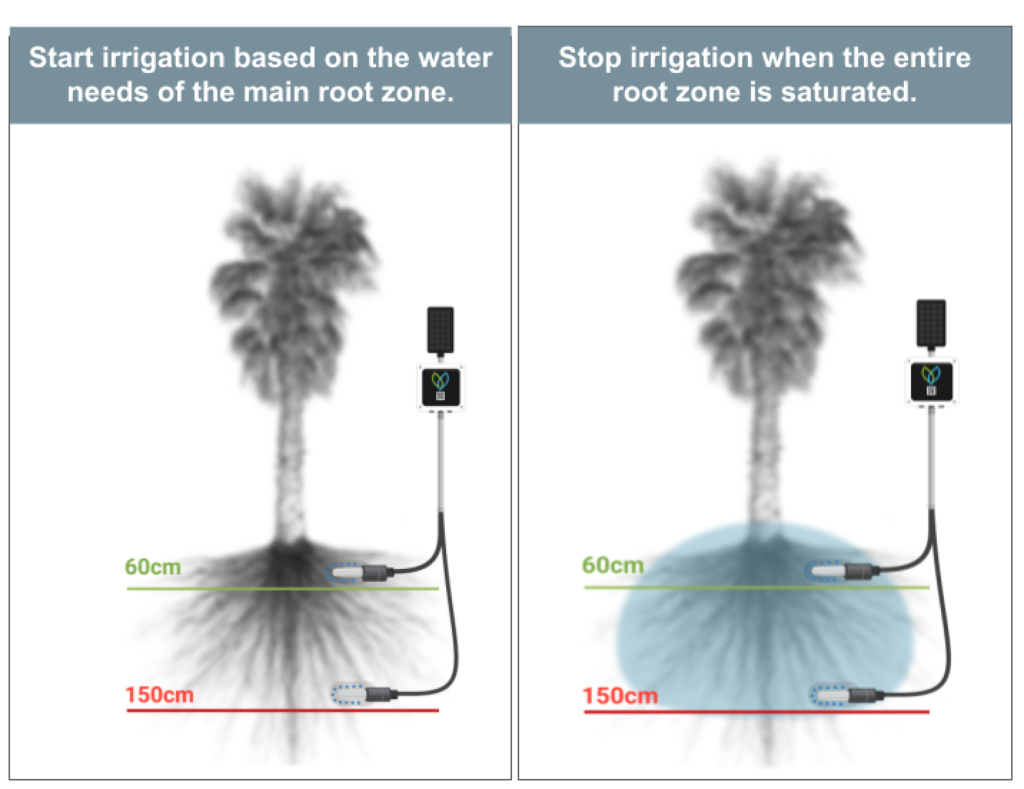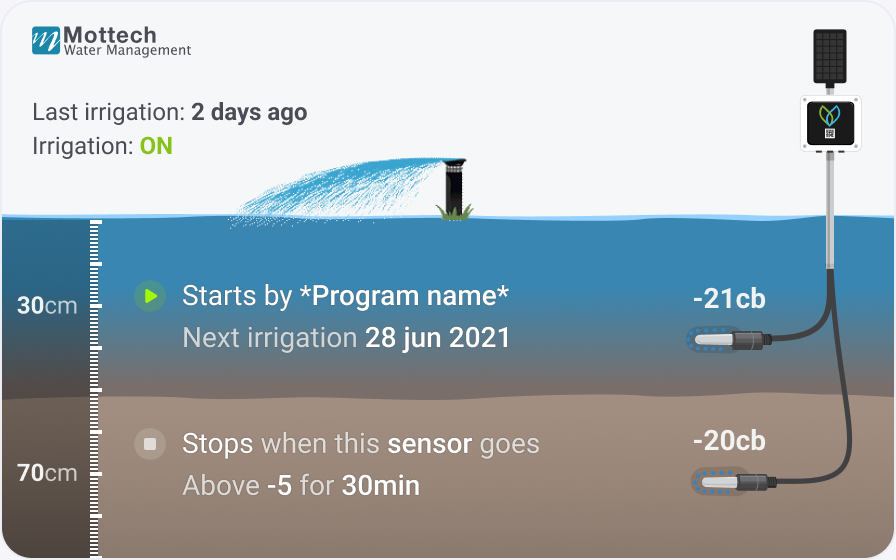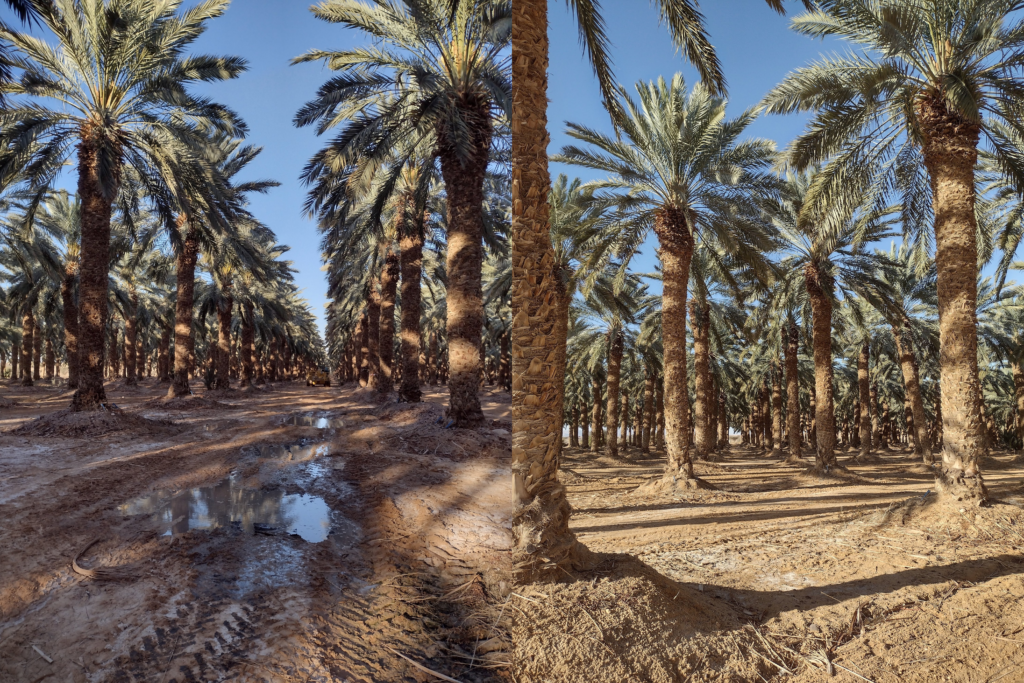
The term “precision irrigation” may sound familiar to you, but I want to clarify and help you understand the importance of precision irrigation in date tree cultivation and the different methods for implementing this technique effectively.
Date palms thrive in desert areas characterized by extreme weather conditions, sandy soils, salinity, and a scarcity of quality water. Irrigation in date cultivation can reach up to 1,000 liters per tree per day during the peak season, which constitutes approximately 20% of the annual growing costs.
The most accepted and advanced irrigation protocols are based on calculating daily evapotranspiration, which involves using a regional meteorological station to estimate how much water has evaporated from the soil and the trees. The method aims to replenish the measured amount through irrigation doses.
However, our experience has shown that this method often leads to excessive irrigation since it does not accurately determine the water consumed by the measured tree, the irrigation depth, the tree’s age, growth stage, water salinity level, microclimate conditions, oxygen levels, salinity levels in the root zone, and the depth of the active root zone. These factors, among others, significantly influence the water consumption of date trees but are often overlooked in current irrigation practices.
What is Precision Irrigation?
Precision irrigation entails providing water to trees at the right time and in the right amount based on their specific needs. This is precisely what Viridix specializes in—helping growers irrigate their trees at the optimal time, in the correct quantity, and using dynamic protocols that respond to the trees’ real-time requirements.
Determining the Right Time for Irrigation
The right time for irrigation is when the tree’s roots can readily absorb water from the surrounding soil while ensuring adequate soil oxygenation. It is crucial to allow the soil to “breathe” since the soil and its environment host a myriad of living organisms that need proper nurturing to maintain fertility over time.
Irrigating at the wrong time can lead to soil sealing, root rot, reduced oxygen levels, decreased fertilizer efficiency, soil salinization, tree stress, flooding, and increased pest infestation.
How Does Viridix Work?
Viridix utilizes a unique water potential sensor called Rootense, which is patented by the company. This sensor simulates an artificial root and competes for water with the soil and the tree’s roots. It measures water potential and serves as the next-generation alternative to outdated tensiometers.
Installing the Rootense sensor involves drilling a hole typically to a depth of 60 cm and 120-150 cm (depending on the tree’s age) and placing the sensors near the roots, directly below the irrigation source above the ground.

Unlike tensiometers, the Rootense sensor doesn’t require calibration or water filling. It remains functional even in the absence of water in the ground and can reach any depth necessary. Once installed, the sensor provides real-time data on root activity, allowing for adjustments to the irrigation system based on a predefined threshold value—indicating the point at which irrigation is needed due to soil dryness.
Determining the Correct Threshold Value
The recommended opening threshold value, which triggers irrigation, is determined by research stations such as in the Arava and Jordan Valley. The final recommendation will be distributed to all growers upon completion. Data analysis from numerous date plantations with Viridix systems installed indicates a threshold value range between 13 and 30 centibars.
Recent developments among some growers involve adjusting the opening value based on the growth stage. For instance, in winter, higher water stress (dryness) may be allowed, while less soil dehydration is permitted in summer. Before harvest, the threshold may be lowered to stress levels.
Practical Application of the Method
Viridix’s Autopilot system can be connected to the irrigation controller independently by the grower. The grower sets the opening threshold value, and when that threshold is crossed, the Autopilot activates the predefined irrigation program in the controller, initiating the irrigation process. The system is compatible with leading controllers such as Mottech and Talgil, and more companies are expected to join in the future.
It is important to note that this method has undergone extensive research for nearly a decade, conducted by renowned researchers in the field. While it has garnered many supporters, it has also faced opposition, as any paradigm shift in history often does.
Advantages and Disadvantages of Precision Irrigation
The precision irrigation method offers several advantages. It prevents date trees from experiencing stress, improves water infiltration in the soil, enhances oxygenation in the root zone, promotes the growth of beneficial microorganisms, and increases the efficiency of fertilizers. On average, it can save approximately 30% of water and fertilizer compared to traditional irrigation methods. However, one disadvantage is that there may be instances where the entire orchard requires water simultaneously, but the irrigation system may not be able to supply enough water to meet the demand. Nonetheless, Viridix is actively working on improving its technology to overcome this limitation in the near future.
Determining the Optimal Watering Depth
Viridix implements techniques to determine the appropriate depth for watering. One approach is to install a Rootense sensor below the root zone, typically between 120-150 cm deep. This sensor provides a signal when water passes through the entire root zone. Any additional water beyond that point becomes unnecessary and only saturates the groundwater. Growers have control over the closing value, allowing them to manage the depth of irrigation. In cases where the water is saline, it is common to include a flushing period to remove salts from the soil.
Different soil types and leaching rates can influence the behavior of the system. The method may also yield different results depending on whether buried drip, sprinklers, or high-flow rate drip systems are used. The precise portioning of water also enables control over the depth of the root zone, offering the option to deepen the roots and enhance tree stability. The portions are dynamic and adapt to the specific conditions of the orchard.
Operating the Irrigation System with Ease
Operating the irrigation system with Viridix’s Autopilot is a comfortable and straightforward process for growers. They can update the irrigation protocol and monitor meteorological stations to ensure accurate and timely irrigation. The Autopilot system allows growers to set two parameters—the opening value and closing value—through a user-friendly mobile app or website. Viridix has emphasized the simplicity of operation, avoiding overwhelming growers with excessive data. The system has become a standard in date cultivation in Israel and globally, with numerous growers adopting it.

Maximizing Yield and Cost Savings
Studies have shown that implementing precision irrigation can save up to 30% of water without compromising fruit size, weight, yield, or ripening percentage when compared to traditional drip irrigation. Growers aiming for maximum savings have achieved even higher water savings, but this may affect fruit size and ripening percentage. Considering the growing competition in the date market, investing in technology that enhances cultivation profitability is essential. By adopting precise irrigation as the central tool for water management, growers can potentially save significant amounts of money. For example, a plantation of 1,000 productive trees implementing adaptive irrigation can save approximately NIS 113,000 per year in water costs alone.

In conclusion, precision irrigation using advanced technologies like Viridix’s Rootense sensors offers a game-changing approach to date tree cultivation. By accurately determining the timing, quantity, and depth of irrigation, growers can optimize water usage, enhance plant health and productivity, and achieve substantial cost savings. With the adoption of precision irrigation, date growers can take a significant step towards sustainable and efficient agricultural practices, ensuring the long-term viability of date cultivation in challenging environments.
Viridix is an Israeli startup that is growing in a world of global warming and climate change, marketing precise irrigation products that show excellent results among growers around the world and all kinds of crops. Viridix is already spread across 22 countries and serves for irrigation in 90 different types of crops – and recently entered the United Arab Emirates and Morocco with a desire to help and grow.
